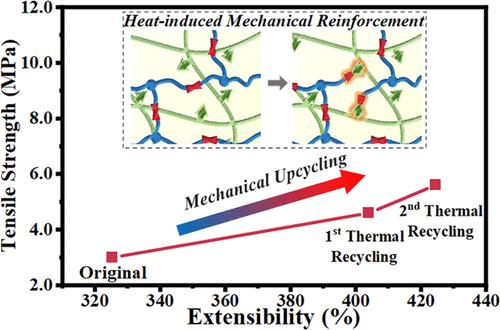当前位置:
X-MOL 学术
›
Macromolecules
›
论文详情
Our official English website, www.x-mol.net, welcomes your feedback! (Note: you will need to create a separate account there.)
Semi-Interpenetrating Polyurethane Network with Fatigue Elimination and Upcycled Mechanical Performance
Macromolecules ( IF 5.5 ) Pub Date : 2024-04-25 , DOI: 10.1021/acs.macromol.4c00389 Xin-Yue Hao 1 , Bing Yu 1, 2, 3 , Lin Li 1 , Hao Ju 1 , Ming Tian 1, 2, 3 , Peng-Fei Cao 1, 3
Macromolecules ( IF 5.5 ) Pub Date : 2024-04-25 , DOI: 10.1021/acs.macromol.4c00389 Xin-Yue Hao 1 , Bing Yu 1, 2, 3 , Lin Li 1 , Hao Ju 1 , Ming Tian 1, 2, 3 , Peng-Fei Cao 1, 3
Affiliation

|
Recyclable elastomers based on adaptable covalent networks fabricated via different types of dynamic bonds have been designed and prepared to resolve the urgent problems generated by waste elastomers. However, due to inevitable side reactions during thermal recycling (e.g., oxidation, permanent cross-linking), mechanical recovery efficiency after thermal recycling is normally <90% for most recyclable elastomers, making it difficult to achieve comparable performance. Herein, we report a novel semi-interpenetrating network design that achieves mechanical reinforcement after thermal recycling via network topology isomerization and formation of new cross-linking points. The designed semi-interpenetrating network includes an aromatic disulfide bond-containing polyurethane network and long linear polyurethane chains with side-chain vinyl groups. Triggered by heat during reprocessing, the disulfide bonds inside the cross-linked network break and the generated phenyl sulfur radicals undergo thiol–ene reactions with the side-chain vinyl groups in the linear polyurethane chains, resulting in increased cross-linking density. Electron paramagnetic resonance testing, in situ Fourier transform infrared spectrometry, high-temperature stress relaxation testing, and cross-linking density measurements were utilized to monitor the process. The tensile strength and extensibility recycling efficiencies reached 186 and 131% of original values after reprocessing twice, realizing mechanical reinforcement after thermal recycling. Interestingly, based on a similar mechanism, mechanical fatigue after repeated stretch and release cycles was efficiently eliminated upon thermal treatment. Such a strategy achieving polymer design with reinforced physical properties after recycling will benefit practical applications of sustainable elastomers and other thermosetting materials.
中文翻译:

具有消除疲劳和升级机械性能的半互穿聚氨酯网络
设计和制备了基于通过不同类型的动态键制造的适应性共价网络的可回收弹性体,以解决废弃弹性体产生的紧迫问题。然而,由于热回收过程中不可避免的副反应(例如氧化、永久交联),大多数可回收弹性体热回收后的机械恢复效率通常<90%,难以达到可比的性能。在此,我们报告了一种新颖的半互穿网络设计,该设计通过网络拓扑异构化和新交联点的形成在热回收后实现机械增强。设计的半互穿网络包括含有芳香族二硫键的聚氨酯网络和带有侧链乙烯基的长线性聚氨酯链。在再加工过程中,在热量的触发下,交联网络内的二硫键断裂,生成的苯基硫自由基与线性聚氨酯链中的侧链乙烯基发生硫醇-烯反应,导致交联密度增加。利用电子顺磁共振测试、原位傅立叶变换红外光谱法、高温应力松弛测试和交联密度测量来监测该过程。两次再加工后拉伸强度和延伸率回收效率分别达到原值的186%和131%,实现了热回收后的机械增强。有趣的是,基于类似的机制,经过热处理,重复拉伸和释放循环后的机械疲劳得到了有效消除。 这种实现回收后具有增强物理性能的聚合物设计的策略将有利于可持续弹性体和其他热固性材料的实际应用。
更新日期:2024-04-25
中文翻译:

具有消除疲劳和升级机械性能的半互穿聚氨酯网络
设计和制备了基于通过不同类型的动态键制造的适应性共价网络的可回收弹性体,以解决废弃弹性体产生的紧迫问题。然而,由于热回收过程中不可避免的副反应(例如氧化、永久交联),大多数可回收弹性体热回收后的机械恢复效率通常<90%,难以达到可比的性能。在此,我们报告了一种新颖的半互穿网络设计,该设计通过网络拓扑异构化和新交联点的形成在热回收后实现机械增强。设计的半互穿网络包括含有芳香族二硫键的聚氨酯网络和带有侧链乙烯基的长线性聚氨酯链。在再加工过程中,在热量的触发下,交联网络内的二硫键断裂,生成的苯基硫自由基与线性聚氨酯链中的侧链乙烯基发生硫醇-烯反应,导致交联密度增加。利用电子顺磁共振测试、原位傅立叶变换红外光谱法、高温应力松弛测试和交联密度测量来监测该过程。两次再加工后拉伸强度和延伸率回收效率分别达到原值的186%和131%,实现了热回收后的机械增强。有趣的是,基于类似的机制,经过热处理,重复拉伸和释放循环后的机械疲劳得到了有效消除。 这种实现回收后具有增强物理性能的聚合物设计的策略将有利于可持续弹性体和其他热固性材料的实际应用。































 京公网安备 11010802027423号
京公网安备 11010802027423号